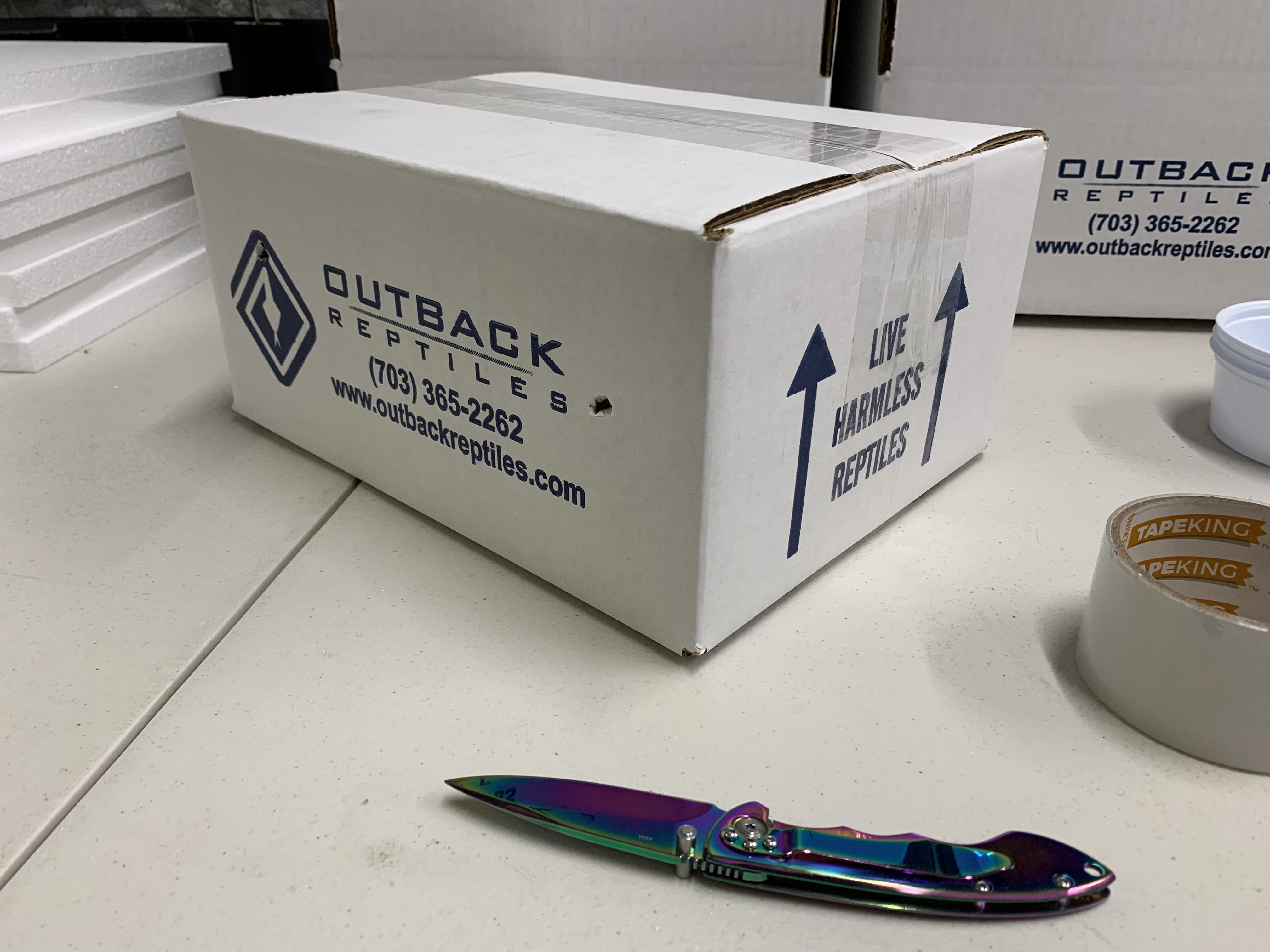We sell a lot of reptiles here, which means it is my responsibility to safely deliver a whole lot of animals to their new homes. On a slow week, I probably ship out around 30-40 boxes of live reptiles. This means I have to be on my “A” game when it comes to packing up boxes – it’s my duty to these animals to keep them safe, and I am proud to say I have a fantastic track record of successfully shipping reptiles to their destinations alive and well. Shipping reptiles is very safe and secure as long as it is done right.
As a prospective breeder, I’m sure you will need to ship animals at some point – so here are some guidelines and tips/tricks on shipping live reptiles, straight from my years of experience. Now, obviously I cannot make any claims or 100% guarantees, but as long as you follow these guidelines then your reptiles should be safe and sound over their shipment to their new home.
Safe Reptile Shipping Weather
The very first thing to consider when shipping live reptiles is the weather. Is today a safe day to ship an animal? This will vary, depending on several factors, but in general it is safe to say that you should not ship if it’s below freezing or if it is above 90 degrees Fahrenheit. The temperature is important in three places – both where you are shipping from, where the package is being routed through, and where the package is arriving. If it’s 60 degrees out at your place, and you’re shipping to Minnesota where it’s 18 degrees… You should reconsider shipping that animal as there is a good chance it will not end well. Likewise, if it’s a nice 70 degree day in your city and you notice the package will be going through the Memphis hub before reaching its final destination, you will want to make sure that the weather in Memphis is acceptable.
To determine which hub your live reptile shipment is traveling through, look at the big capital letters above the bottom bar code on your label. The first letter tells you which hub:
X – Memphis, TN
N – Indianapolis, IN
E – Newark, NJ
A – Fort Worth, TXW – Oakland, CA
Q – Los Angeles, CA
G – Atlanta, GA
If you are shipping in state, this code will begin with a number instead of a letter.
Another thing to consider, besides just the temperature, are the weather conditions. Even if it is not necessarily below freezing, if it is supposed to snow heavily at any point in the journey, this could cause delays that will certainly be bad news for your reptile. I would not ship if there are snow storms or thunderstorms forecast for the hub your box will be traveling through as this will certainly cause delays.
So in short, check your local weather, the weather at the destination, and the weather at the hub in between. The weather at your final destination is the most important as this is where your reptile will be traveling around in a delivery truck during the morning / afternoon and will be most exposed to the weather.
Side Note: Legality?
As many states have different laws pertaining to the legality of keeping pet reptiles, it is very important to read up on local regulations before shipping animals. For example, Large constrictors such as Burmese Pythons, Retics, etc are banned in NY but they are legal in many other states. To avoid a hefty fine or possible jail time, DEFINITELY check with local laws before you make the mistake of breaking one. You can and will be held responsible for following all laws and local regulations regarding both native and exotic species.
When to use Heat Packs / Cold Packs
Heat packs and cold packs are vital tools in ensuring that our reptiles are shipped safely and arrive alive and well. These do not make it necessarily safe to ship in otherwise unsafe shipping conditions, but they do add an extra layer of protection from the weather. The purpose of Heat or Cold packs is not to heat or cool your box to an exact stable temperature, but rather to act as a thermal buffer so that the contents do not heat up or cool down too much during shipment as this can cause unnecessary stress or even the death of your animal.
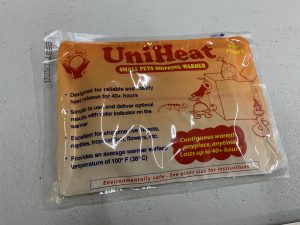 Heat packs are absolutely vital during the colder months of the year. Before I go any further, I will add this disclaimer: DO NOT use “hand warmer” type heat packs that you can buy at Wally world, convenience stores, etc. These are made to get very warm for a brief period of time (usually 4-6 hours) and they are NOT safe for shipping live reptiles. They get too hot, too quickly and they burn out too quickly as well. At 4 hours into the journey your reptile has likely not even left your state. Use only heat packs designed specifically for live animal shipping. Most reptile/ ball python breeders (including us) use Uni Heat brand heat packs (Click here to order through Amazon) as they have a long track record of success. I prefer 40 hour heat packs – they have a nice, long burn that keeps moderately warm temperatures over about twice the amount of time they need to for overnight delivery. That way, if there is a delay, they will last the extra day needed.
Heat packs are absolutely vital during the colder months of the year. Before I go any further, I will add this disclaimer: DO NOT use “hand warmer” type heat packs that you can buy at Wally world, convenience stores, etc. These are made to get very warm for a brief period of time (usually 4-6 hours) and they are NOT safe for shipping live reptiles. They get too hot, too quickly and they burn out too quickly as well. At 4 hours into the journey your reptile has likely not even left your state. Use only heat packs designed specifically for live animal shipping. Most reptile/ ball python breeders (including us) use Uni Heat brand heat packs (Click here to order through Amazon) as they have a long track record of success. I prefer 40 hour heat packs – they have a nice, long burn that keeps moderately warm temperatures over about twice the amount of time they need to for overnight delivery. That way, if there is a delay, they will last the extra day needed.
As anybody who is shipping a reptile should be aware, these animals are cold blooded so they cannot regulate their own body temperature. Tropical species really shouldn’t be exposed to temperatures below 70 Fahrenheit for more than brief periods of time, so when it’s cold outside and we need to ship one, heat packs help regulate that temperature inside the box. If it will be below ~60 degrees where your animal will be arriving, definitely use a heat pack. Do not ship if it’s below 32 degrees – once water freezes, this will deactivate your heat pack and it will produce NO heat whatsoever, as water is necessary for the chemical reaction to occur.
This is where a little bit of discretion will come into play as some animals are more sensitive than others, and some deal with heat and cold differently. For example, I would much rather a frog got a little bit cold than a little too warm. Amphibians can handle slightly cool temperatures way better than they can handle it being too hot. Whereas a Uromastyx or other desert species can definitely take a little extra heat over it being too cold. So if the temperatures are close, think about what you’re shipping and how they would react either way. When using a heat pack, always open it and let it activate for about an hour or so before putting it in the box and sealing it. Heat packs take 30-60 minutes to “activate” and get up to temperature, and they need a lot of oxygen to do so. Always leave the heat pack on a flat surface with the red stripe facing up. This side has little perforations that allow oxygen into the bag so that the chemical reaction can occur. Never cover the red stripe as this will deactivate the heat pack. I’ll go over proper placement of heat packs down below under the section on How to Pack Your Box.
 Cold Packs come in several forms – Blocks full of liquid (think that you would pack in a lunch box) or sometimes plastic pouches full of gel. Both of these stay in the freezer until ready to ship. I like “Ice Brix” because they are cheap and easy to use. (Order Here) They are filled with a liquid or gel that is resistant to absorbing heat quickly – this way they stay cool for a long time, and keep the contents of your box cool as well. If it’s going to be over 80 degrees or so at any stage of the journey, include a cold pack to make sure your animals don’t overheat. But again, think about what you’re shipping – if it’s a Uromastyx or a Bearded Dragon or something, and the temperatures are in the mid 80’s over the whole route, then you can probably get away without using a cold pack. I’ll go over proper placement of cold packs down below under the section on How to Pack Your Box.
Cold Packs come in several forms – Blocks full of liquid (think that you would pack in a lunch box) or sometimes plastic pouches full of gel. Both of these stay in the freezer until ready to ship. I like “Ice Brix” because they are cheap and easy to use. (Order Here) They are filled with a liquid or gel that is resistant to absorbing heat quickly – this way they stay cool for a long time, and keep the contents of your box cool as well. If it’s going to be over 80 degrees or so at any stage of the journey, include a cold pack to make sure your animals don’t overheat. But again, think about what you’re shipping – if it’s a Uromastyx or a Bearded Dragon or something, and the temperatures are in the mid 80’s over the whole route, then you can probably get away without using a cold pack. I’ll go over proper placement of cold packs down below under the section on How to Pack Your Box.
Shipping Supplies
So here’s what we’ll need to ship your reptiles properly:
- Insulated shipping box. This will be a cardboard box with an inner lining of styrofoam, usually 1/2″ or 3/4″ thick. Can order through Superior Shipping Supplies
- Properly sized snake bag or deli cup to secure your reptile inside the shipping box. I also get these from Superior. A pillow case works for larger animals.
- Packing material to help insulate as well as secure your box contents in place (I prefer newspaper)
- Heat or Cold packs as necessary depending on the weather (See above)
- Strong packing tape
- FedEx overnight shipping label. I do not use UPS as they do now allow shipping of live snakes. It is illegal to send reptiles and amphibians through USPS so do not attempt this.
How to Pack Your Shipping Box
Proper, efficient packing is the second most important factor (besides the weather) in safely shipping live animals. Follow these guidelines and your animals will thank you for it when they arrive healthy and happy!
Choose a proper sized shipping box for your shipment. There should be plenty of space for either the cup your reptile is in, or the bag, to sit comfortably but you do not want a lot of empty space. Too little space means your animal is more vulnerable to temperature swings, and too much means it could bounce around a lot during shipping.
Now, make sure your box is insulated well. The entire inside of the box should be lined with styrofoam, either 1/2″ or 3/4″. I prefer 3/4″ as it offers the most protection from temperature swings, but on mild days 1/2″ is just fine. If there are large gaps in the styrofoam or missing pieces, then this insulation is essentially useless so make sure that it is snug and fully encompasses the inside of the box.

Now some people poke holes in the box, and some do not. I tend to go back and forth – I’ll gauge the weather and decide if I want more ventilation or less. A typical shipping box is not air tight so you do not need to put holes for your animals to breathe, but if it’s especially hot then I like to add a few holes to enhance air flow. However, if you are using a sealed single-piece styrofoam box with lid (think, omaha steak shipping container) you definitely need to poke a few holes as these ones are air tight.
Line the inside bottom of the box with several layers of newspaper. I usually crumple the paper first so that is makes a nice, fluffy, cushioned layer on the bottom. This will protect your reptile from the inevitable bumps and jostling it will encounter through FedEx, and it will also provide another thermal barrier from wherever the box may be sitting. Think, sitting on a cold metal stadium bench or sitting on a cushion on that same cold metal. One more layer of protection for your animal.
Your reptile should be safely contained in either a plastic cup or a cloth bag. I prefer to use cups for smaller fragile animals as it offers a bit of protection, and bags for larger ones. Make sure the cup has air holes. This goes without saying but I’ve received animals before where the shipper forgot to punch holes, and as you can imagine it did not end well. Whatever container you use, it should be large enough for the animal to sit comfortably but not so large that there is unnecessary space to jostle around. I always make sure to include some bedding inside the cup or shredded paper in the bag to absorb any liquids if your reptile decides to go to the bathroom during the trip.
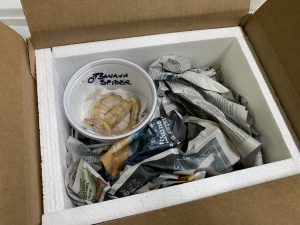
Pad the empty space around the animal’s container with more crumpled paper. This will protect your reptile from the inevitable bumps, jostling, and possible drops as FedEx transports the box from point A to point B.
Now, if using a cold pack, I usually slide that inside along the inside edge of the styrofoam, so that it’s in the main compartment of the box with the animal but separated by some layers of paper. I don’t want the cold part actually touching the bag or cup as this will be too cold. We want the ice pack to keep the box cool, but we don’t want to freeze our reptile either!
When using a heat pack, there are several ways to position it that are ideal for different situations. In no circumstance do I ever let the heat pack directly contact the animal or the container the animal is shipping in, for the same reasons as the cold packs. I want the heat pack to radiate heat throughout the box to keep it stable but we definitely don’t want to cook our animal either. The surface of the heat pack itself will get up over 100 degrees (the exact temp depends on the type of heat pack used) so we don’t want that touching anything that can overheat.
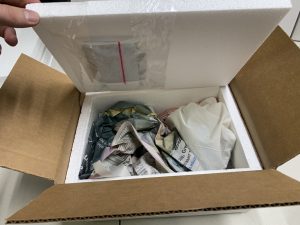
If i’m shipping a single animal in a small box, I’ll tape the heat pack on the inside of the lid so that it is suspended over the contents of the box, without touching them. Wherever possible, I’ll try to position it so that the heat pack isn’t directly over the deli cup / snake bag so that the heat is indirect instead of blasting right down on the animal. I prefer using 12x9x6″ boxes for single small animals as this gives me room to put the animal on one side of the box and the heat pack suspended over the other side of the box. If you decide to use a 7x7x7 or 7x7x6 box, keep in mind you’re only saving a couple dollars on the shipping fee and it’s a little bit less safe to use with a heat pack as it will be directly over the animal.
Another option is to put the heat pack inside a deli cup (again, make sure it has holes) and putting that in the box alongside the animal. Make sure that you pad it a little bit so the cups arent touching directly. This is also a good method when shipping larger boxes with multiple animals. I will put a couple heat packs in deli cups spaced between the animals in the box so that the entire box is heated evenly. Sometimes bigger boxes tend to get a little too cool if the heat packs are only taped to the lid and none are down below.
The last method I occasionally use, is to create a vented divider out of styrofoam and block off a compartment in the box for a heat pack to sit in. This way it’s mostly insulated from the rest of the box, but there are holes for warm air to ventilate through and keep your animal safe. I like using this method if it’s right on the cusp of needing a heat pack, or maybe it’s warm enough in some parts of the journey, but cooler at the destination. This helps ensure that there’s no risk of overheating. It’s also great for sensitive animals like amphibians or delicate geckos that need a little heat, but can’t handle a lot of it.
Of course, feel free to combine these methods for larger boxes with multiple animals, for the best effects. If i’m shipping big boxes with dozens of animals, I’ll sprinkle a few deli cupped heat packs in the bottom and maybe one or two taped tot he lid as well. Use your best judgement and always keep in mind, that a little bit too cold is better than overheating. Reptiles can recover from being a bit chilled, but overheating can cause brain damage and other problems very easily.
Should I Ship to my Customer’s Door or the FedEx Hub for Pickup?
FedEx offers two options – home delivery and hold for pickup. It is always safer to have your shipment held at the local FedEx ship center where your customer can go and pick it up. This way your reptile box is held safe and secure in a climate controlled building. if you choose Hold for Pickup, make sure you chose an actual FedEx Ship Center and not a Walgreens, Kinkos, FedEx Office, etc. as these locations will not always accept live animals. FedEx Ship Centers will ALWAYS accept live animals so unless you know the exact FedEx location and that their employees will take Live Animals, choose a Ship Center and not a FedEx Office.
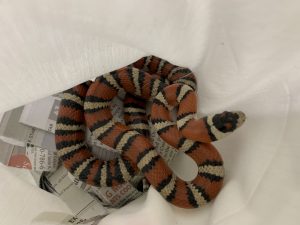
If you opt for Home Delivery, the package will leave that same hub early in the morning on a truck to be delivered to the home address. Depending on where the customer is located, this delivery will take place either by 10:30am, 12:00 noon, or before 4:30pm if they are far from the hub. When you generate the shipping label it will state the guaranteed delivery time. If it says 4:30, you may want to opt for Hold for Pickup instead, as it is a lot more risky to have a box bouncing around a hot or cold delivery truck all day. Always select Direct Signature Required when shipping live animals. It is not safe for animals to be left on the porch in the sun, rain, snow, or what have you. This way you also get a verified time of arrival and you know that your customer received the animal.
I recommend always shipping to the FedEx Ship Center if there is any question about the weather or if your customer might not be around during the designated arrival window. If it’s on the verge of being too hot or too cold, choose the Ship Center so that the box won’t be stuck in the back of that truck out in the bad weather. If your customer has a busy schedule or won’t be able to get to the door, have it held at the Ship Center so they can go grab the box at their earliest convenience. When in doubt, hold at hub for safety.
This is also better for your own security as a seller, as your customer will need to present photo ID to pick up the package. If your customer is hesitant to present a photo ID to pick up an animal that they purchased from you, this is a huge red flag that they may be perpetrating fraud against you. Do not ship to any other name or address that is not associated with their payment method and you will be protected in the event of fraud.
Now that your box is all packed up, heat packed, cold packed, etc. Seal it up, tape it shut, and label the contents by species and quantity. This is required by law in some states (California and Florida). I usually label them anyways regardless of what state they are going to. You don’t need to go too crazy – as
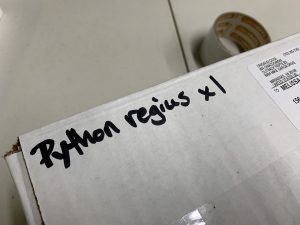
long as the box is labelled LIVE HARMLESS REPTILES on a couple sides, and the quantity and scientific name are on top, you are good to go.
Need a Shipping Label?
If you do not have your own FedEx account, then your best bet will be to order a shipping label through one of several reptile shipping companies. These companies do not ship animals – they simply offer discounted shipping labels through FedEx as they purchase these labels in bulk at discounted rates. I like Redline Shipping, personally, as they offer great rates and live arrival insurance is available. They also have a dedicated crew of staff who are there to help in the event of any issues with the shipment. Click here to visit their site to order your discounted shipping label.
Always select priority overnight as the shipping option. This way your box is guaranteed to arrive by the next day, at the earliest time that they guarantee for that service area.
Now attach the label to the top of the box and you’re all ready to drop it off at the nearest FedEx ship center. I always try to drop off my packages at the latest drop off time so they are in transit for as little time as possible. If your local FedEx hub accepts overnight shipments up until 9pm, I’d suggest dropping off around 8 so they have time to process the box, without it sitting around their warehouse all day.
You can also request a pickup from FedEx. I would recommend using this option if the weather is mild, but not if it’s super hot or cold out – this is one more risk added to the journey as your box will be driven around all evening before the pickup vehicle makes its dropoff at the ship center. If you do choose this method, select the latest pickup time available. Mine is between 4-6pm.
After Shipping
Now that your reptile is on its way to his or her new home, there’s a couple things you should do.
First, make sure the recipient has the tracking number. This way they can follow the shipment all the way to their door or local Fedex hub. If it is set to hold at hub, they’ll need this number in order to pick it up (as well as their ID).
It’s a good idea to keep an eye on the shipment yourself as well. This way if there are any delays along the way, you will know and you can alert your recipient so that they know ahead of time as well. Follow up with your customer as soon as you see that the box arrived so that you can check that everything made it safe and sound.
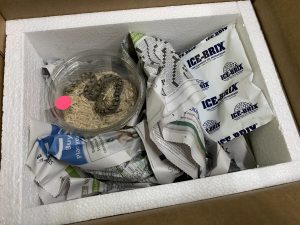
If there are any issues or delays, you can call FedEx’s 800 number for support. You’ll need the tracking number as some proof that you are the shipper (usually knowing the shipping address is enough). They can run a track and trace to see where the package is if it has not arrived when it was supposed to. I have personally found that the first person you talk to on their 800 line is useless and cannot tell you anything that is not already accessible via their website tracking system. If you need real help (your customer missed the delivery and wants them to re-attempt, or meet the driver somewhere, etc) then you will usually need to escalate the call to a higher up. This is where it pays off to use a secondary shipping label like Redline Shipping – these guys both have dedicated teams who will solve these issues for you.
Now, that was a pretty long read and I hope I was clear with all the info I presented. If you have any questions pertaining this tutorial or shipping reptiles in general, feel free to get in touch with me and I am happy to help. Hopefully you now have the tools and knowledge to safely and effectively ship your animals anywhere in the country.
Thanks
Mike Schultz
Outback Reptiles

